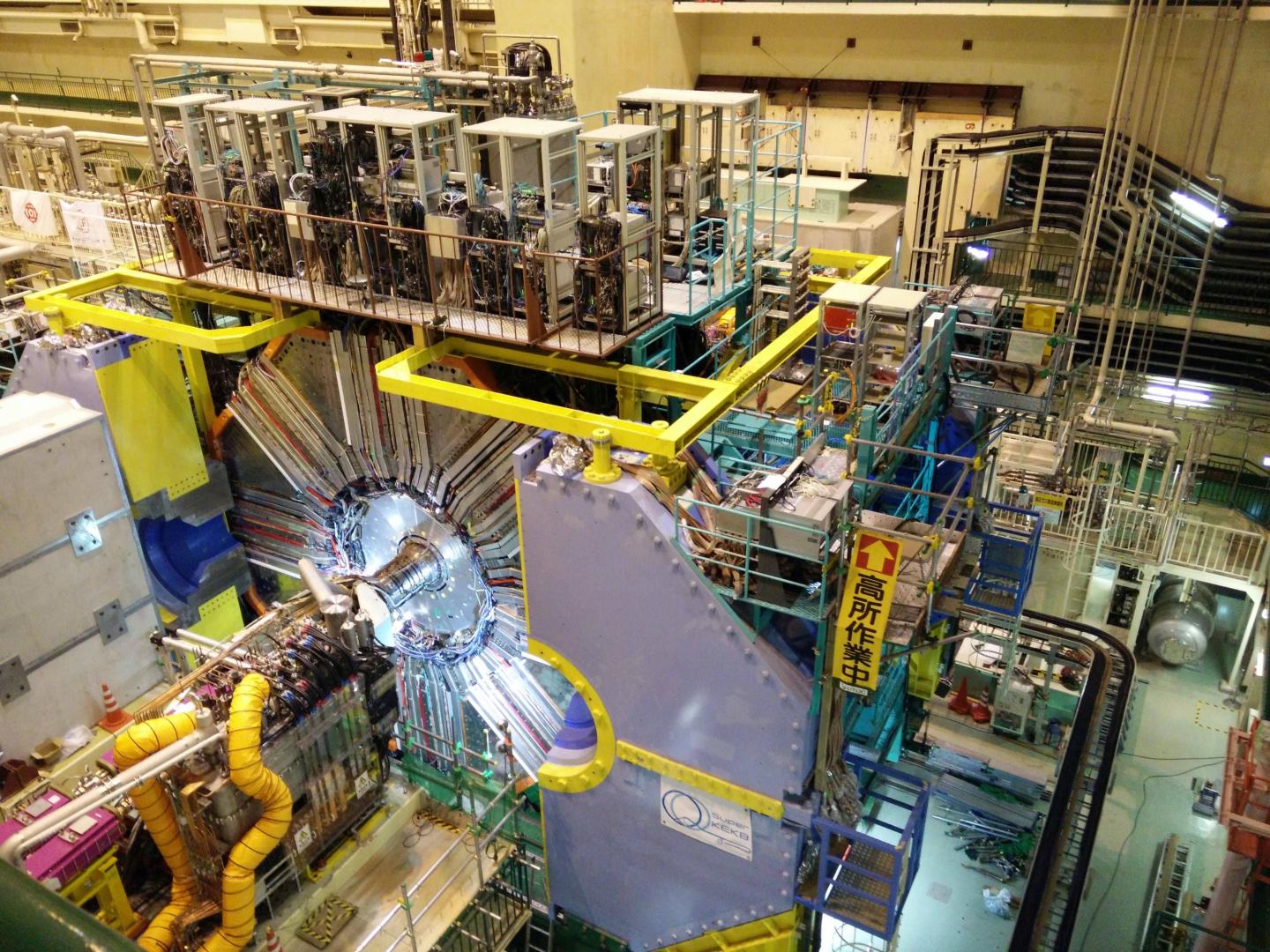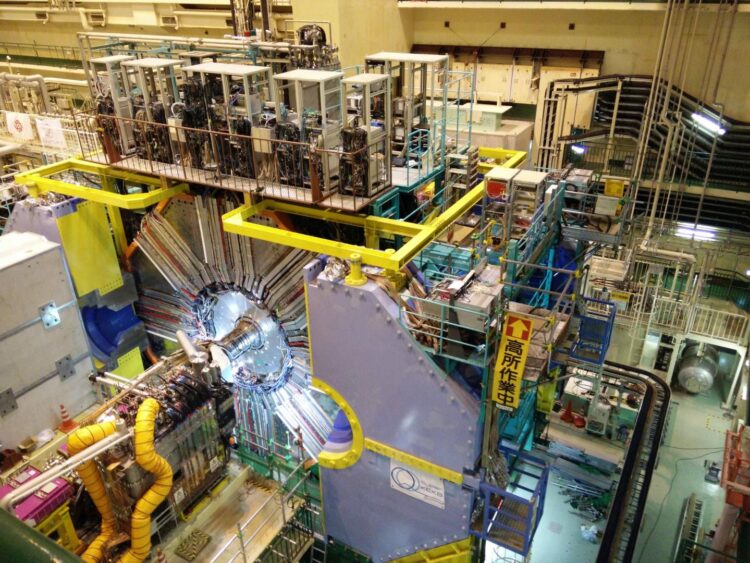KIT scientists participate in the Belle II accelerator experiment that has now published first results

Credit: Felix Metzner, KIT
At the Japanese High-energy Accelerator Research Organization, KEK, in Tsukuba, about 50 kilometers north of Tokyo, the Belle II experiment has been in operation for about one year now. An international team of researchers also from Karlsruhe Institute of Technology (KIT) is searching for exotic particles that are to enhance our understanding of dark matter in the universe. For one of these particles, the so-called Z’ boson, mass and coupling strengths have now been limited with previously unattainable accuracy. The results have just been published in the renowned Physical Review Letters.
The Belle II experiment has been collecting data from physical measurements for about one year now. After several years of upgrading work, both the SuperKEKB electron-positron accelerator and the Belle II detector have been improved compared to their predecessors in order to achieve a 40-fold higher data rate.
Scientists from twelve institutes in Germany are involved in constructing and operating the detector, developing evaluation algorithms, and analyzing the data. For Belle II, KIT has developed software for the reconstruction of particle tracks, designed and produced application-specific integrated circuits (ASICs) for data readout, constructed hardware with modern machine-learning algorithms to detect particle tracks, and performed calculations to link future Belle II data to fundamental theories of elementary particle physics. “Work of KIT is characterized in particular by a close cooperation of physicists and electrical engineers,” says Professor Ulrich Nierste of KIT’s Institute for Theoretical Particle Physics, whose working group carries out theoretical studies for the experiment.
With the help of Belle II, scientists are searching for traces of new physics that can be used to explain the unequal occurrence of matter and anti-matter or the mysterious dark matter. One of the so far undiscovered particles that the Belle II detector is looking for is the Z’ boson – a variant of the already detected Z boson that acts as an exchange particle for the weak interaction.
As far as we know, about 25% of the universe consists of dark matter, whereas visible matter accounts for just under 5% of the energy budget. Both forms of matter attract each other through gravity. Dark matter thus forms a kind of template for the distribution of visible matter. This can be seen, for example, in the arrangement of galaxies in the universe.
Link between Dark and Normal Matter
The Z’ boson might play an interesting role in the interaction between dark and visible matter. It could be a kind of mediator between the two forms of matter. The Z’ boson can – at least theoretically – result from the collision of electrons (matter) and positrons (anti-matter) in the SuperKEKB and then decay into invisible dark matter particles. “The Z’ boson can thus help scientists understand the behavior of dark matter, and what is more, the discovery of the Z’ boson could also explain other observations that are not consistent with the standard model, the fundamental theory of particle physics,” Ulrich Nierste explains.
Important Clue: Detection of Muon Pairs
But how can the Z’ boson be detected in the Belle II detector? Not directly, that much is sure. Theoretical models and simulations predict that the Z’ boson could reveal itself through interactions with muons, the heavier relatives of electrons. If scientists would discover an unusually high number of muon pairs of opposite charge after the electron-positron collisions as well as unexpected deviations in energy and momentum conservation, this would be an important indication of the Z’ boson.
However, the new Belle II data have not yet provided any indication of the Z’ boson. But with the new data, the scientists can limit the mass and coupling strengths of the Z’ boson with previously unattainable accuracy.
More Data, More Precise Analyses
These first results are obtained from the analysis of a small amount of data collected during the startup phase of SuperKEKB in 2018. Belle II went into full operation on March 25, 2019. Since then, the experiment has been collecting data while continuously improving the collision rate of electrons and positrons. When the experiment will be perfectly tuned, it will provide far more data than used in the recently published analyses. The physicists thus hope to gain new insights into the nature of dark matter and other unanswered questions. “More data will open up new opportunities to study dark matter: Decays of heavy mesons may produce Z’ bosons or other “dark” exchange particles that leave the detector, but are still noticed as a deficit in the energy balance of decay,” explains Dr. Goldenzweig, whose working group of KIT’s Institute of Experimental Particle Physics has specialized in such measurements.
###
The German working groups in the Belle II experiment are funded by the following institutions and programs:
- German Federal Ministry of Education and Research: Framework program “Exploring the universe and matter” (ErUM)
- German Research Foundation (DFG) within the framework of the Excellence Strategy launched by the federation and the federal states:
„ORIGINS”: EXC-2094 – 390783311
„Quantum Universe”: EXC-2121- 390833306 - European Research Council
- European Union’s Horizon 2020 – grant agreement No 822070
- Helmholtz Association
- JENNIFER under the European Union’s Horizon 2020 program
- Max Planck Society
Original publication:
Search for an invisibly decaying Z’ boson at Belle II in e+e- ? μ+ μ- (e+ – μ- +) + missing energy final states, The Belle II Collaboration, Physical Review Letters, DOI: 10.1103/PhysRevLett.124.141801
Press contact:
Dr. Joachim Hoffmann, Press Officer, Tel.: +49 721 608-21151, joachim hoffmann?kit edu
Being “The Research University in the Helmholtz Association”, KIT creates and imparts knowledge for the society and the environment. It is the objective to make significant contributions to the global challenges in the fields of energy, mobility, and information. For this, about 9,300 employees cooperate in a broad range of disciplines in natural sciences, engineering sciences, economics, and the humanities and social sciences. KIT prepares its 24,400 students for responsible tasks in society, industry, and science by offering research-based study programs. Innovation efforts at KIT build a bridge between important scientific findings and their application for the benefit of society, economic prosperity, and the preservation of our natural basis of life. KIT is one of the German universities of excellence.
Media Contact
Monika Landgraf
[email protected]
Original Source
https:/




